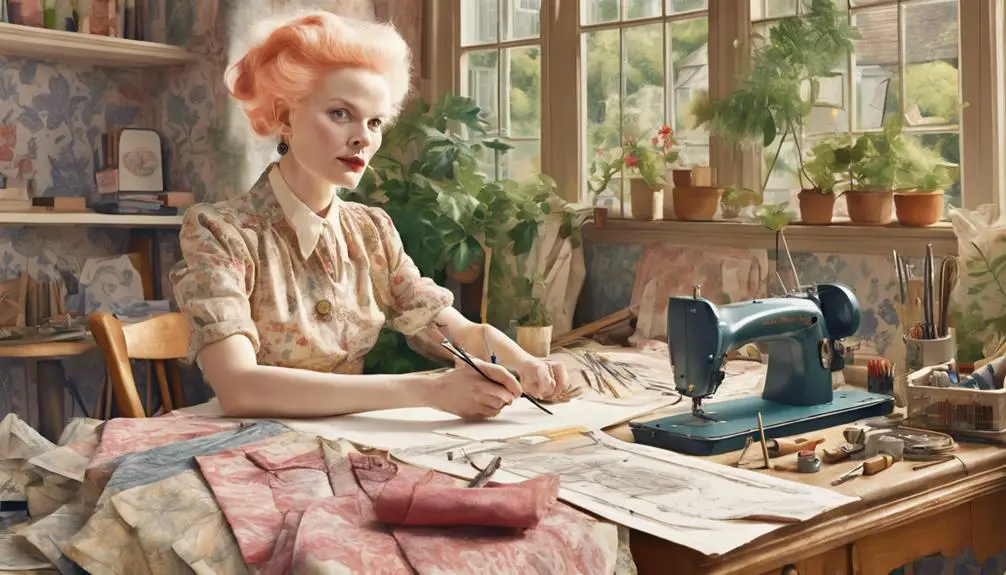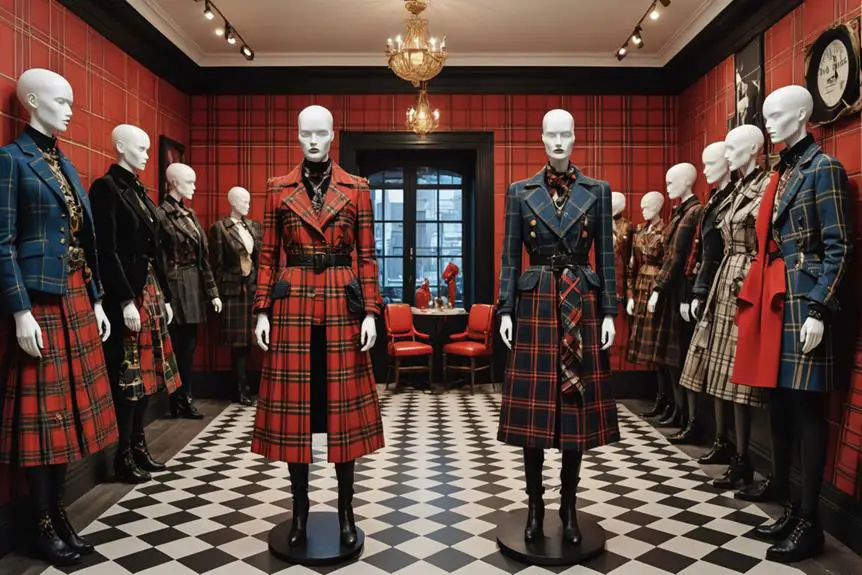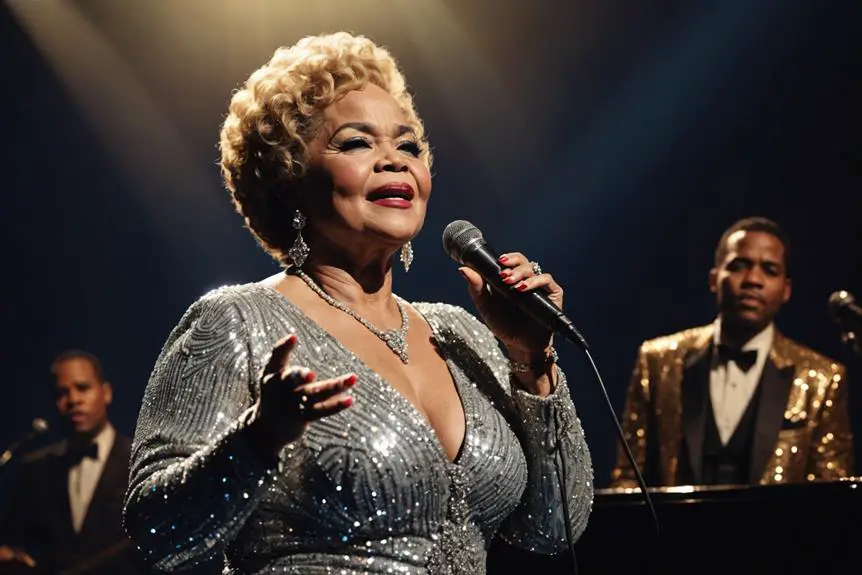Vivienne Westwood's story begins in Derbyshire, where she grew up in a modest home. After marrying and teaching, she plunged into fashion design, showcasing her talents in London. In 1971, she and Malcolm McLaren opened the "Let It Rock" boutique, becoming a punk fashion landmark. Her bold designs, like bondage trousers and iconic collections, combined rebellion with historical influences. Westwood challenged societal norms, using fashion as a platform for social commentary, advocating for environmental awareness, and sustainability. As you explore further, you'll see how her legacy continues to inspire and reshape the fashion landscape today.
Early Life and Background

Vivienne Westwood's journey began in modest surroundings, born on April 8, 1941, in Glossop, Derbyshire, England, to a cobbler father and a mother who worked in a cotton mill. Growing up with modest means shaped her resilient spirit.
At 17, she moved to Harrow, where she took on factory work while also becoming a primary school teacher. During this time, her fascination with fashion design blossomed, marking the beginning of her path as a self-taught designer.
Vivienne Isabel Westwood didn't just create dresses; she crafted her identity, showcasing her entrepreneurial spirit through her innovative designs. Even while teaching, she devoted her evenings to designing clothing and jewelry, reflecting her drive and creativity.
In 1962, she married Derek Westwood and welcomed their son, Benjamin, the following year. However, the marriage ended in divorce in 1965, a pivotal moment that led her to meet Malcolm McLaren. This meeting would prove essential in shaping her career.
Her early experiences in the fashion and music scenes laid the groundwork for what would later emerge as her iconic influence on punk culture. As she blended her design knowledge with the energy of the evolving punk movement, it became clear that Westwood was destined to redefine fashion.
With each step, she transformed her challenges into opportunities, paving the way for a legacy that would resonate far beyond her modest beginnings.
The Birth of Punk Fashion
In the early 1970s, a radical shift in fashion began to emerge, fueled by the rebellious spirit of youth culture. At the forefront of this movement was Vivienne Westwood, who opened her first boutique, Let It Rock, in 1971. This shop quickly evolved, becoming a vital hub for punk fashion by 1980.
With provocative designs that included bondage trousers and ripped T-shirts, Westwood challenged societal norms and captured the attention of the press like never before. Her early experiences in crafting and design, as well as her education in the arts, laid the groundwork for her innovative approach to fashion design, ultimately leading to a unique blend of craftsmanship and rebellion early experiences ignited passion.
Collaborating with Malcolm McLaren, Westwood found inspiration in the raw energy of the Sex Pistols, the iconic punk rock band. This partnership helped shape the punk aesthetic, blending music and fashion in a way that resonated deeply with disenchanted youth.
The 1977 Anarchy Shirt, featuring bold graphics and slogans, served as a powerful medium for political commentary, reflecting the frustrations of the time.
In 1981, Westwood took a bold step into the fashion world with her Pirate Collection, her first official catwalk show. This collection showcased a unique mix of punk style and historical references, solidifying her status as a key figure in the fashion movement.
Through her innovative and rebellious designs, Vivienne Westwood not only defined punk fashion but also established a lasting legacy that continues to influence designers and inspire individuals today.
Influential Collections and Designs

Westwood's influential collections continue to redefine the landscape of fashion, blending historical references with contemporary audacity. One of her landmark achievements is the Pirate Collection, launched in 1981, which marked her first official catwalk show. This collection liberated 1970s silhouettes, marrying punk influences with historical styles.
In 1982, the Savage Collection took things a step further, drawing inspiration from artists like Matisse and Picasso. It introduced slashed sleeves and bold graphics, challenging traditional fashion norms and showcasing Westwood's fearless creativity.
Moving into the 1980s, the Punkature Collection emphasized sustainability through the use of recycled materials and distressed fabrics, embodying the punk ethos of reusing and repurposing.
Around the same time, the Hypnos Collection redefined casual wear by presenting active sportswear as high fashion, blurring the lines between everyday clothes and runway aesthetics.
Fast forward to 2019, and you encounter the Chaos Point Collection, which explicitly highlighted chaotic crises and showcased Westwood's commitment to sustainability. This collection reflects her evolution as a designer who not only shapes the fashion industry but also engages with urgent social issues.
Throughout her career, Vivienne Westwood has consistently pushed boundaries, earning accolades like Designer of the Year while inspiring others to think critically about fashion's role in addressing environmental concerns. Each collection serves as a demonstration of her innovative spirit and dedication to making a statement.
Cultural Impact and Social Commentary
Fashion has long been a canvas for social commentary, and Vivienne Westwood's designs have continually pushed the envelope on this front. From the punk era to modern-day collections, Westwood's work has challenged societal norms and sparked significant conversations. You can see how she intertwines fashion with cultural commentary through her bold designs and innovative approaches.
Here are three key aspects of her impact:
- Rebellion Against Tradition: During the punk era, Westwood's collections, like the famous 1977 Anarchy Shirt, became symbols of rebellion against established values. She used fashion to voice dissent and encourage others to question the status quo.
- Historical Influences: Westwood often drew inspiration from history, fusing it with modern narratives. Her collections, such as "Vive la Bagatelle" and "Five Centuries Ago," reveal her knack for blending past and present, making social themes accessible through clothing.
- Climate Awareness: More recently, Westwood's commitment to addressing pressing issues like climate change has gained attention. Through initiatives like the Climate Revolution foundation and her "Do It Yourself" collection, she advocates for sustainability while inspiring change in the fashion industry.
Additionally, her introduction of wedding gowns in the early 1990s critiqued societal expectations surrounding love and marriage.
Vivienne Westwood's fashion house remains a powerful platform for cultural commentary, encouraging you to think critically about the world around you.
Legacy and Ongoing Innovations

Vivienne Westwood's legacy is undeniably rich, marked by her groundbreaking influence as the "godmother of punk." Continuously pushing boundaries, the House of Vivienne Westwood embraces innovation while staying true to its roots. Known for her pioneering spirit, Westwood shaped fashion trends and cultural movements through her bold designs and passionate political activism.
After her passing in December 2022, her husband, Andreas Kronthaler, committed to carrying on her legacy, ensuring that creativity and cultural commentary remain at the heart of the brand.
Today, the House isn't just about fashion; it's about making a statement. Recent collections reflect social and environmental themes, with pieces like "Chaos Point" emphasizing the importance of ecological awareness and childhood innocence.
Moreover, the brand is leading the way in sustainable practices. By using organic materials and promoting a "Make Do and Mend" ethos, they challenge the fast fashion model, encouraging consumers to think about the environmental impact of their choices.
The brand's global presence has also expanded, with flagship stores and unique initiatives, including Vivienne Westwood cafes in Shanghai and Hong Kong, enhancing its cultural reach.
Through creativity and a commitment to progressive ideals, the House of Vivienne Westwood continues to innovate and inspire, proving that fashion can be a powerful vehicle for change.
As you explore this iconic brand, you'll find that its legacy isn't just about clothing; it's a call to engage with the world around you.




